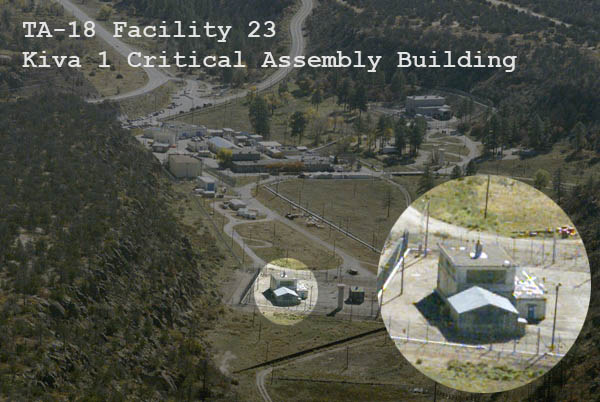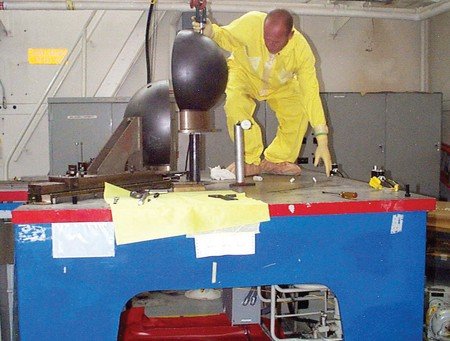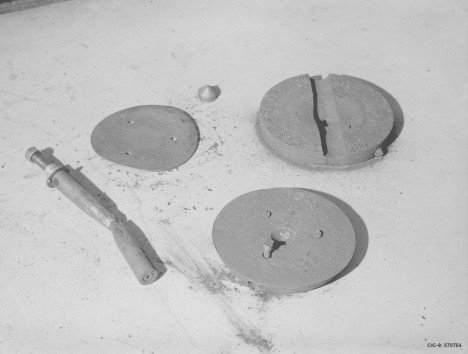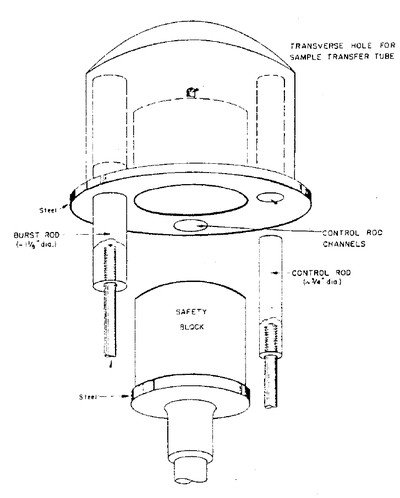The beginning of the atomic era. Godiva device
Nuclear physicists from the Los Alamos National Laboratory were not only talented people, but also poetic in their own way. Robert Oppenheimer, inspired by a poem by an English poet of the 17th century, gave the code name for the first nuclear weapon test in history - Trinity. The bombs dropped on Hiroshima and Nagasaki, and later on the Bikini Atoll, had their own names. Finally, a device for conducting experiments with the critical state of a radioactive substance was named after Lady Godiva, the wife of Duke Leofric of Coventry.

Lady Godiva, according to legend, rode through the streets of the city naked so that her husband could reduce taxes for his subjects. Whether this legend is true or not is unknown, but since then her name has become a symbol of both courage and openness, helplessness.
After the tragic events with the Devil's core, experiments with critical states began to be carried out with the help of remote-controlled devices. Why was it even necessary to play with fire or, according to Feynman, “tickle the dragon's tail”? First, the behavior of the substance itself was studied, and secondly, various samples, materials and laboratory animals were irradiated with a powerful stream of neutrons and gamma rays.
')

General view of zone TA-18, Kiva 1 building is highlighted - “Godiva’s house”
For these purposes, the technical zone TA-18 was used - a complex of several buildings located 6 kilometers southeast of Los Alamos. TA-18 successfully operated until the end of 2006, it collected a lot of devices of various designs and simultaneously conducted up to hundreds of different experimental programs. In December 2006, the last four vehicles were disassembled and moved to storage in another technical area. The Los Alamos War List (LANL Newsletter) solemnly announced the end of an era of critical experimentation and compared cars with precious vintage cars sent to storage in a garage museum. But we are running ahead.

Dismantling Flattop, one of four pulsed reactors, prior to storage
When experimenting with critical states, it was important to stop in time. Uncontrolled development of a chain reaction could lead to a real nuclear explosion. Back in 1942, cadmium control rods (safety rods) were used when building the first nuclear reactor in Chicago. Cadmium absorbs neutrons, and in the case of "emergency braking" of the reactor, it was necessary to quickly introduce rods into the core. This was the responsibility of a specially trained man with an ax at the ready (ax man). Emergency rods were hung on ropes, which at the right moment were cut by an ax. The whole system “man-ax-rope-rod” was called SCRAM - safety control rod ax man. In English, scram also means "hasty escape." The term later became part of the professional English-speaking slang of nuclear scientists, in the Russian language there is no such term, there is simply “emergency protection”.
So, going back to critical devices - in fact, these were the same primitive nuclear reactors, in which the chain reaction was not maintained all the time, but started for a short period of time. Later the class of such devices was called "pulse reactors". Godiva's predecessor was a car called Jamima, and it was designed in such a way that in case of an accident, it was possible to “hastily escape” from the chain reaction avalanche itself. It consisted of two sets of uranium disks: one pack was fixed motionless, and the second rose to it, forming the total mass of the radioactive substance, which is close to critical. On April 18, 1952, due to incorrect calculations, an extra number of disks were “charged” to the device, and the car entered a critical state. However, the explosion did not happen. The released energy threw the bottom pack of disks away from the upper one, after which the chain reaction automatically stopped.

“The Godfather” of Godiva can be considered Professor Otto Frisch. The list of his merits is extensive: these are studies of the behavior of neutrons, calculations of the energy of fission of uranium nuclei, and an estimate of the critical mass of uranium necessary for a nuclear explosion. He was one of the key physicists involved in the Manhattan project. The name of the beautiful lady came to his mind, since the whole structure, in his opinion, was "naked and naked."
However, the device looks more like a two-meter mechanistic skeleton with an “atomic heart” inside. This design was chosen to minimize the reflection of neutrons, which could lead to a chain reaction running out of control.

The “heart” of Godiva is a ball of enriched (93.7%) uranium-235 with a diameter of about 17 centimeters and a total weight of 53 kilograms, divided into three parts. For comparison, the mass of the “Kid” uranium charge dropped on Hiroshima was 64.1 kilograms. For the “fine tuning” on the surface of the ball, 14 grooves were made, in which small uranium disks weighing from 50 to 100 grams were inserted.
During the experiments, parts of the ball were connected together, and a uranium rod was quickly inserted through the top tube, initiating a chain reaction. This stage was carried out remotely, but the maintenance of Godiva and, in particular, the addition of uranium disks, was done manually.
Despite a significant step forward compared with the experiments of the 40s, carried out with bare hands, the new critical devices remained extremely dangerous. One day in 1954, Frisch almost died: he was next to Godiva’s assembled “heart.” The human body reflects much less neutrons than tungsten or beryllium carbide, but also a small amount of them is enough to start a chain reaction. Frisch noticed this in the light of the indicator lamp and managed to react, bouncing off the ball and tearing it apart. A second delay would have caused his death.

The experiments continued until February 12, 1957, when Godiva entered a critical state. This time, as in the case of Jemima, the device automatically turned off. But the energy of the chain reaction seriously damaged the metal frame, and Godiva was declared unsuitable for repair. The personnel who conducted the experiment were in a protected area, none of the scientists was injured. During her lifetime, Godiva produced about a thousand neutron pulses.

Melted details Godiva after the incident. Left - uranium rod that triggers the reaction
To replace Godiva in 1957, a new device was built - Godiva II, Godiva II. By design and principle of operation was similar to its predecessor. But, paradoxically, it sounds, she was much better protected. A separate building with half-meter-thick concrete walls was equipped for it, also with its own name - Kiva, in honor of the ritual structures of ancient Indians.

Instead of a ball, a uranium cylinder with a notch was used now, into which a cylinder of smaller diameter was inserted from the bottom (the so-called safety block). The total mass of uranium was increased to 57 kilograms. The triggering rod was inserted into one of three channels drilled in the main cylinder, the other two were intended for control rods. In addition, a transverse channel was drilled in the main cylinder for irradiated samples and materials. The core was surrounded by a metal mesh. It did not allow any object reflecting neutrons to be brought closer to the cylinder and accidentally start a chain reaction, as happened with Otto Frisch.

The machine was controlled completely remotely, there was no need to manually enclose the uranium disks, as in Godiva the First, the weight was adjusted by control rods. A cooling system is also provided - each pulse strongly heated uranium cylinders. The position of the trigger rod was calibrated in advance to the nearest tenths of a millimeter, and the whole experiment lasted about 40 milliseconds. Instead of a man with an ax, radiation sensors were used here, which included at the right time a pneumatic system that lowered the inner cylinder and stopped the reaction.
Later, other "sisters" of Godiva were built, and more complex structures with a power of pulses several orders of magnitude greater than those of the first devices. The last car, Godiva IV, has successfully worked for more than 30 years.

"The End of an Era": LANL specialists are preparing to dismantle Godiva Fourth
Godiva Device on Wikipedia
Applications of Godiva II Neutron Pulses (PDF)
A. Lukin. Physics of Pulsed Nuclear Reactors (PDF)
Los Alamos Critical Assemblies Facility (PDF)
A Review of Criticality Accidents: 2000 Revision (PDF)
LANL Newsletter, Nov. 21, 2005 (PDF)
LANL Newsletter, Dec. 4, 2006 (PDF)

Lady Godiva, according to legend, rode through the streets of the city naked so that her husband could reduce taxes for his subjects. Whether this legend is true or not is unknown, but since then her name has become a symbol of both courage and openness, helplessness.
Technical Zone TA-18
After the tragic events with the Devil's core, experiments with critical states began to be carried out with the help of remote-controlled devices. Why was it even necessary to play with fire or, according to Feynman, “tickle the dragon's tail”? First, the behavior of the substance itself was studied, and secondly, various samples, materials and laboratory animals were irradiated with a powerful stream of neutrons and gamma rays.
')

General view of zone TA-18, Kiva 1 building is highlighted - “Godiva’s house”
For these purposes, the technical zone TA-18 was used - a complex of several buildings located 6 kilometers southeast of Los Alamos. TA-18 successfully operated until the end of 2006, it collected a lot of devices of various designs and simultaneously conducted up to hundreds of different experimental programs. In December 2006, the last four vehicles were disassembled and moved to storage in another technical area. The Los Alamos War List (LANL Newsletter) solemnly announced the end of an era of critical experimentation and compared cars with precious vintage cars sent to storage in a garage museum. But we are running ahead.

Dismantling Flattop, one of four pulsed reactors, prior to storage
Man with an ax
When experimenting with critical states, it was important to stop in time. Uncontrolled development of a chain reaction could lead to a real nuclear explosion. Back in 1942, cadmium control rods (safety rods) were used when building the first nuclear reactor in Chicago. Cadmium absorbs neutrons, and in the case of "emergency braking" of the reactor, it was necessary to quickly introduce rods into the core. This was the responsibility of a specially trained man with an ax at the ready (ax man). Emergency rods were hung on ropes, which at the right moment were cut by an ax. The whole system “man-ax-rope-rod” was called SCRAM - safety control rod ax man. In English, scram also means "hasty escape." The term later became part of the professional English-speaking slang of nuclear scientists, in the Russian language there is no such term, there is simply “emergency protection”.
So, going back to critical devices - in fact, these were the same primitive nuclear reactors, in which the chain reaction was not maintained all the time, but started for a short period of time. Later the class of such devices was called "pulse reactors". Godiva's predecessor was a car called Jamima, and it was designed in such a way that in case of an accident, it was possible to “hastily escape” from the chain reaction avalanche itself. It consisted of two sets of uranium disks: one pack was fixed motionless, and the second rose to it, forming the total mass of the radioactive substance, which is close to critical. On April 18, 1952, due to incorrect calculations, an extra number of disks were “charged” to the device, and the car entered a critical state. However, the explosion did not happen. The released energy threw the bottom pack of disks away from the upper one, after which the chain reaction automatically stopped.
Otto Frisch and First Godiva

“The Godfather” of Godiva can be considered Professor Otto Frisch. The list of his merits is extensive: these are studies of the behavior of neutrons, calculations of the energy of fission of uranium nuclei, and an estimate of the critical mass of uranium necessary for a nuclear explosion. He was one of the key physicists involved in the Manhattan project. The name of the beautiful lady came to his mind, since the whole structure, in his opinion, was "naked and naked."
However, the device looks more like a two-meter mechanistic skeleton with an “atomic heart” inside. This design was chosen to minimize the reflection of neutrons, which could lead to a chain reaction running out of control.

The “heart” of Godiva is a ball of enriched (93.7%) uranium-235 with a diameter of about 17 centimeters and a total weight of 53 kilograms, divided into three parts. For comparison, the mass of the “Kid” uranium charge dropped on Hiroshima was 64.1 kilograms. For the “fine tuning” on the surface of the ball, 14 grooves were made, in which small uranium disks weighing from 50 to 100 grams were inserted.
During the experiments, parts of the ball were connected together, and a uranium rod was quickly inserted through the top tube, initiating a chain reaction. This stage was carried out remotely, but the maintenance of Godiva and, in particular, the addition of uranium disks, was done manually.
Despite a significant step forward compared with the experiments of the 40s, carried out with bare hands, the new critical devices remained extremely dangerous. One day in 1954, Frisch almost died: he was next to Godiva’s assembled “heart.” The human body reflects much less neutrons than tungsten or beryllium carbide, but also a small amount of them is enough to start a chain reaction. Frisch noticed this in the light of the indicator lamp and managed to react, bouncing off the ball and tearing it apart. A second delay would have caused his death.

The experiments continued until February 12, 1957, when Godiva entered a critical state. This time, as in the case of Jemima, the device automatically turned off. But the energy of the chain reaction seriously damaged the metal frame, and Godiva was declared unsuitable for repair. The personnel who conducted the experiment were in a protected area, none of the scientists was injured. During her lifetime, Godiva produced about a thousand neutron pulses.

Melted details Godiva after the incident. Left - uranium rod that triggers the reaction
Godiva II
To replace Godiva in 1957, a new device was built - Godiva II, Godiva II. By design and principle of operation was similar to its predecessor. But, paradoxically, it sounds, she was much better protected. A separate building with half-meter-thick concrete walls was equipped for it, also with its own name - Kiva, in honor of the ritual structures of ancient Indians.

Instead of a ball, a uranium cylinder with a notch was used now, into which a cylinder of smaller diameter was inserted from the bottom (the so-called safety block). The total mass of uranium was increased to 57 kilograms. The triggering rod was inserted into one of three channels drilled in the main cylinder, the other two were intended for control rods. In addition, a transverse channel was drilled in the main cylinder for irradiated samples and materials. The core was surrounded by a metal mesh. It did not allow any object reflecting neutrons to be brought closer to the cylinder and accidentally start a chain reaction, as happened with Otto Frisch.

The machine was controlled completely remotely, there was no need to manually enclose the uranium disks, as in Godiva the First, the weight was adjusted by control rods. A cooling system is also provided - each pulse strongly heated uranium cylinders. The position of the trigger rod was calibrated in advance to the nearest tenths of a millimeter, and the whole experiment lasted about 40 milliseconds. Instead of a man with an ax, radiation sensors were used here, which included at the right time a pneumatic system that lowered the inner cylinder and stopped the reaction.
Later, other "sisters" of Godiva were built, and more complex structures with a power of pulses several orders of magnitude greater than those of the first devices. The last car, Godiva IV, has successfully worked for more than 30 years.

"The End of an Era": LANL specialists are preparing to dismantle Godiva Fourth
Links
Godiva Device on Wikipedia
Applications of Godiva II Neutron Pulses (PDF)
A. Lukin. Physics of Pulsed Nuclear Reactors (PDF)
Los Alamos Critical Assemblies Facility (PDF)
A Review of Criticality Accidents: 2000 Revision (PDF)
LANL Newsletter, Nov. 21, 2005 (PDF)
LANL Newsletter, Dec. 4, 2006 (PDF)
Source: https://habr.com/ru/post/97836/
All Articles